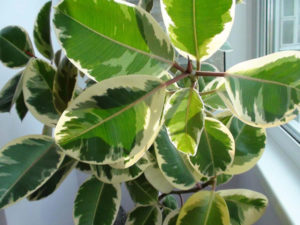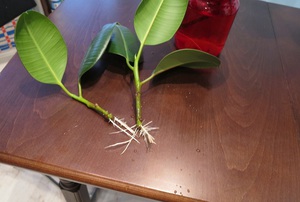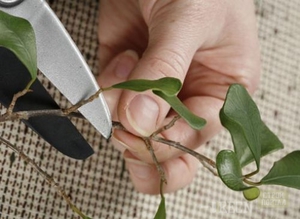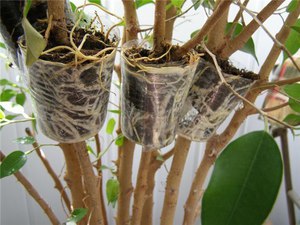If you look into the houses of domestic flower growers, then most likely you can find such a plant as ficus. Many show interest in him not only because of the love of exoticism. Indeed, for many it is also important that it does not cause problems in care.
In recent years, more and more novice florists have been trying to acquire this indoor plant. Because of this, flower lovers are still interested in what conditions the ficus grows best, and what are the ways to reproduce it at home, how to root the ficus.
Content
What is indoor ficus
 Distinguished in external grace and ease of care, ficus is one of the preferred types of indoor plants, which will be appropriate not only in an ordinary apartment, but also in an office space.
Distinguished in external grace and ease of care, ficus is one of the preferred types of indoor plants, which will be appropriate not only in an ordinary apartment, but also in an office space.
Its useful qualities are not limited only to decorativeness, because it can maintain clean indoor air. This mulberry provides more than 900 varieties. And, despite the fact that they are found in different places on our planet, each of these varieties has healing properties.
For the treatment of skin diseases, it is useful to use ficus leaves. The fruit, which is called figs, is also valuable, because in addition to the original taste, it also has useful properties.
However, not all types of ficus are suitable for growing at home. Representation of this genus of plants includes different forms of ficus - handicraft, tree-like and ampelous... Moreover, among them, two tree-like forms can be distinguished, which are most widespread - Rubber and Benjamin.
Growing features
 If you decide to start growing a ficus house, then it is best to go to the store for it in spring or summer. After all, it is important to protect this plant from temperature fluctuations. Regardless of the variety, ficus is extremely reacts poorly to change in temperature mode.
If you decide to start growing a ficus house, then it is best to go to the store for it in spring or summer. After all, it is important to protect this plant from temperature fluctuations. Regardless of the variety, ficus is extremely reacts poorly to change in temperature mode.
Drafts, which should be excluded during leaving, as well as choosing a place for ficus, do not benefit him either. Ficus feels best if it is grown in a well-lit placewhich must be protected from direct sunlight.
If you were able to get a ficus with dark leaves, then it is permissible to put it in partial shade. Experts recommend not to rush to choose a place for a flower, because here you need to do everything correctly without having to change the place.
It should be borne in mind that the ficus is one of those rare plants that quickly get used to a new place, so a change in growing conditions will negatively affect its development.
Watering and temperature conditions
 Maintaining a favorable temperature regime is one of the factors for the successful cultivation of ficus at home.
Maintaining a favorable temperature regime is one of the factors for the successful cultivation of ficus at home.
Moreover, at different times of the year, the temperature will differ: in summer, the optimal temperature for ficus is within + 20 ... + 25 degrees, and in winter from + 12 to + 17.
No less important for ficus and watering. In the summer, you need to especially carefully monitor the ficus and constantly keep the soil moist, however, avoid gulfs.
To determine the frequency of such events, it is necessary to take into account the variety of ficus. If a dwarf plant grows in your home, then watering may be more frequent.
Otherwise, you need to take care of all other species, which should be provided with more rare but plentiful watering. In addition, you need to carry out activities to maintain an optimal humidity level.
In summer this can be achieved by spraying plantsusing settled water. There is also an alternative way - containers filled with water can be placed next to the ficus pots.
Reproduction of ficus at home
 I would like to repeat that ficuses are classified into three main types. And regardless of the species you choose for growing, you can easily get material for breeding from it.
I would like to repeat that ficuses are classified into three main types. And regardless of the species you choose for growing, you can easily get material for breeding from it.
True, in each case this event will be held with some differences. The least time-consuming is the reproduction of ampelous ficus, since it requires a minimum of time for rooting.
The situation is somewhat different with shrubs and tree-like forms, since their reproduction is a longer process in time, because later you will have to spend more energy on caring for cuttings or other planting material.
To date, the florist has the opportunity to choose one of the following methods of ficus propagation:
- grafting;
- leaf (stalk with leaf);
- air layering.
However, in this case, you must not forget to follow the general recommendations for any type of ficus that you decide to propagate at home:
- It is recommended to root rubber ficus in a warm season - for example, in spring or early summer.
- Due to the fact that ultraviolet light has a depressing effect on young specimens, it is not recommended to grow them in direct sunlight.
- When you have a cut stalk in your hands, it is recommended to rinse the cut site with water, because after this traumatic operation, juice may begin to flow from it. Next, you need to place the shoot in fresh air to dry the "wound".
- Ficus can propagate by cuttings, but it should be borne in mind that it is undesirable to use young shoots for these purposes, since it will not work to wait for the roots from them. Lignified shoots are the most suitable for grafting.
- If you plan to propagate tree-like forms of ficuses, for example, Rubber-bearing, then the planting material is recommended to be taken from the upper part of the trunk or you can cut out a piece of the stem, which must have at least one node.
Cuttings
 When using this breeding method, they harvest cuttings 15-17 cm long... A sharp knife is definitely required here, and the operation itself is recommended to be carried out on one of the warm spring days.
When using this breeding method, they harvest cuttings 15-17 cm long... A sharp knife is definitely required here, and the operation itself is recommended to be carried out on one of the warm spring days.
Having counted the required distance from the top, while the first node should be at least 1 cm, it is necessary to make an oblique cut. When you receive the cutting, all leaves must be removed from it.
If you are borrowing a stalk from a large-leaved ficus, then the leaves present on it can be cut to half the length.
Having received the planting material, it placed in a containerfilled with water. When propagating rubbery ficus by cuttings, it is advisable to make a mini-greenhouse in order to speed up the rooting process.
In this case, the whole procedure will take no more than 2-5 weeks. When you notice young small leaves on the cuttings, this is a sure sign that it's time to transplant in individual pots.
Using cuttings with a leaf
When using this propagation method, cuttings that have a leaf are harvested. During harvesting, the shoot must be cut at an angle, and this must be done directly along the internode on the tree trunk.
After receiving the cutting it placed in the groundso that it is hidden in it until the very bottom of the sheet. In addition, it will be necessary to carry out certain actions with the sheet: it is folded up and fixed in this position using a soft thread.
Subsequently, for the cuttings, similar care measures are taken as in the case of using ordinary cuttings. As a rule, this method allows, on average, to obtain a new seedling in 3-4 weeks.
However, in some cases there may be a delay or, conversely, the process may speed up, it all depends on the species that you are going to breed.
Propagation by air layers
At first, this operation was carried out mainly to rejuvenate the plant. However, it can also help in obtaining new ficus plants at home.
You can propagate by air layers adult specimens, which have long lost their decorative effect, as well as rather tall varieties, which have greens only on the tops.
 The first step is to select the height of the trunk at which the air cut will be harvested.
The first step is to select the height of the trunk at which the air cut will be harvested.- Further, in the selected place, the sheet is removed, where subsequently you need to make a small incision. Insert a match or a chip into the resulting wound.
- Then, the moistened moss is placed directly on the incision, this place is wrapped with plastic wrap.
- You need to make sure that there is air under the film, and for this, its upper and lower parts should be fixed as tightly as possible on the barrel. Subsequently, in relation to the plant, similar care measures are taken, as before propagation by layering.
Usually, using this method, you can get new bushes after three weeks. This time will be enough for new roots to form at the incision site.
However, for now, the film should still be on the barrel. You can understand that it is time to remove it when many young roots appear on the surface of the moss. Further, the film is removed and the top is cut off, which subsequently transplanted into an individual container.
Tips from experienced florists
Ficus is one of the most common indoor plants not only abroad, but also in our country. Moreover, many not only successfully grow it in their apartment, but also reproduce it on their own.
There are a lot of options for obtaining new plants from ficus, however, in order to choose the most suitable one, it is useful at the beginning familiarize yourself with each of them... Indeed, some breeding methods may not be suitable for a florist for certain reasons.
At the same time, one must not forget that, regardless of the chosen propagation method, the seedling needs provide appropriate care.
Since without proper attention it will be difficult to count on the fact that an equally ornamental plant can be grown from a ficus seedling obtained in one way or another.


